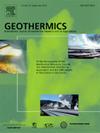Conceptual numerical modeling of low-temperature nitrogen geothermal systems on the Verkhne-Paratunsky and Paratunsky fields
IF 3.5
2区 工程技术
Q3 ENERGY & FUELS
引用次数: 0
Abstract
The Paratunsky and Verkhne-Paratunsky fields (Kamchatka, Russia) are examples of low-temperature nitrogen (LT N2) geothermal systems that are widespread throughout the world and are believed to have formed as a result of penetration of meteoric water into deep faults and heat mining from host rocks under background heat flow and temperature gradient conditions. However, no one has tested the geologically long-term thermal recharge capability of such systems to be recharged by heat and water under real 3D environmental conditions. A solution to this unsolved problem has been obtained here using specific examples.
The two closely spaced reservoirs are 15 km apart, composed of volcanogenic rocks of Eocene-Quaternary age and characterized by shallow permeability reservoirs underlain by extinct volcanic conductive roots, where 60–90 °C thermal N2 SO4![]() Na waters circulate. The Paratunsky reservoir has a 60-year history of intensive exploitation (150–250 kg/s), while the Verkhne-Paratunsky reservoir is just being brought into development.
Na waters circulate. The Paratunsky reservoir has a 60-year history of intensive exploitation (150–250 kg/s), while the Verkhne-Paratunsky reservoir is just being brought into development.
Application of a simple radial-cylindrical (RZ) model to the Verkhne-Paratunsky geothermal system allowed us to show the principal possibility of formation of a circulating hydrothermal system in a structure with a radius of about 15 km and a circulation depth of -3 km within the first thousand years at a temperature of 60 °C and a flow rate of 60 kg/s.
Then a three-dimensional numerical (3D) model of the Verkhne- Paratunsky and Paratunsky low-temperature nitrogen geothermal system was constructed, assuming that the upper part of the pre-Cretaceous basement is a permeable conduit surface and the roots of extinct volcanoes provide vertical down-flow recharge and up-flow discharge of this natural heat and mass circulation system. This numerical model covers all significant thermal discharge features, recharge area of the adjacent highlands. Subsequent modeling confirms the possibility of increasing the temperature to 80 °C, diluting the initially brine-saturated NaCl permeable reservoirs and maintaining up-flow rate at observed values for thousands of years from the onset of hydrothermal circulation.
Verkhne-Paratunsky和Paratunsky气田低温氮地热系统概念数值模拟
Paratunsky和Verkhne-Paratunsky气田(堪察加半岛,俄罗斯)是低温氮(LT N2)地热系统的例子,这种地热系统在世界范围内广泛存在,被认为是在背景热流和温度梯度条件下,由于大气水渗透到深部断层和从主岩石热开采而形成的。然而,还没有人测试过这种系统在真实的三维环境条件下通过热和水进行长期热补给的地质能力。本文通过具体实例给出了这个未解决问题的解决方案。两个储层间距15 km,由始新世—第四纪火山岩组成,储层为浅渗透储层,下伏为死火山导电根,60 ~ 90℃热N2 SO4Na水循环。Paratunsky水库有60年的集约开采历史(150-250 kg/s),而Verkhne-Paratunsky水库刚刚开始开发。对Verkhne-Paratunsky地热系统的简单径向-圆柱形(RZ)模型的应用使我们能够展示在温度为60°C,流速为60 kg/s的情况下,在一个半径约为15 km,循环深度为-3 km的结构中形成循环热液系统的主要可能性。在此基础上,建立了Verkhne- Paratunsky和Paratunsky低温氮地热系统的三维数值模型,假设前白垩纪基底上部为可渗透管道面,死火山的根部为该自然热物质循环系统提供垂直向下补给和向上释放的能量。该数值模型涵盖了邻近高地所有重要的热排放特征和补给区。随后的模拟证实了将温度提高到80°C的可能性,稀释了最初饱和盐水的NaCl渗透性储层,并在热液循环开始后的数千年内保持观测值的上升速率。
本文章由计算机程序翻译,如有差异,请以英文原文为准。
求助全文
约1分钟内获得全文
求助全文
来源期刊

Geothermics
工程技术-地球科学综合
CiteScore
7.70
自引率
15.40%
发文量
237
审稿时长
4.5 months
期刊介绍:
Geothermics is an international journal devoted to the research and development of geothermal energy. The International Board of Editors of Geothermics, which comprises specialists in the various aspects of geothermal resources, exploration and development, guarantees the balanced, comprehensive view of scientific and technological developments in this promising energy field.
It promulgates the state of the art and science of geothermal energy, its exploration and exploitation through a regular exchange of information from all parts of the world. The journal publishes articles dealing with the theory, exploration techniques and all aspects of the utilization of geothermal resources. Geothermics serves as the scientific house, or exchange medium, through which the growing community of geothermal specialists can provide and receive information.
 求助内容:
求助内容: 应助结果提醒方式:
应助结果提醒方式:


